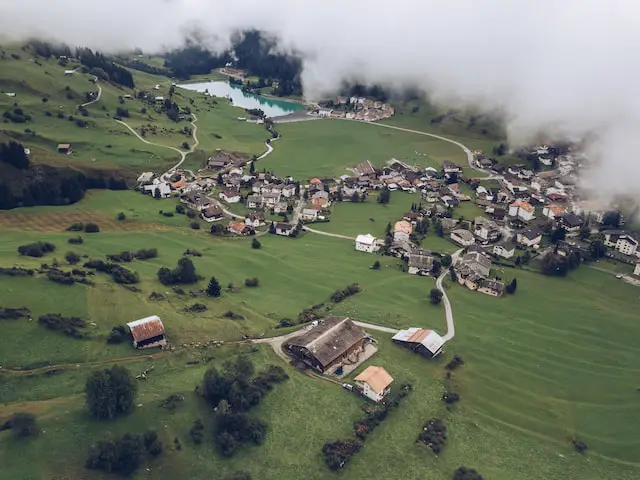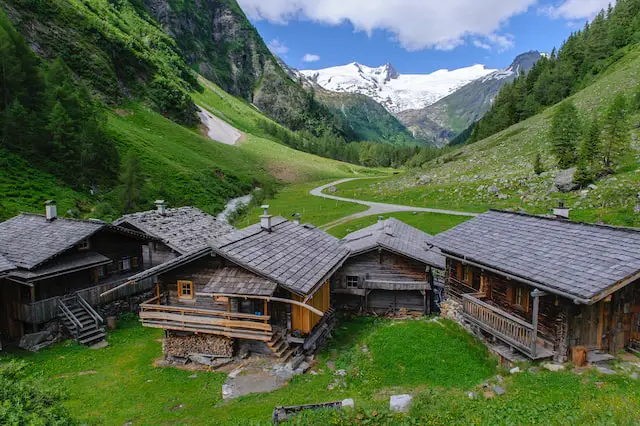The differences between a hamlet and village are substantial. Hamlets tend to be small, rural settlements with few permanent residents and limited services, while villages are larger communities that provide more amenities such as shops, schools, and other public facilities.
Hamlets
(Photo by Xavier von Erlach on Unsplash )

Hamlets are small settlements which are typically found in rural areas. They are usually located near a larger village or town, and often consist of a few houses and farms. Hamlets typically have a small population, and most residents are engaged in agriculture or other rural pursuits.
Villages
(Photo by Nigel Tadyanehondo on Unsplash )

Villages are larger settlements than hamlets, and are typically found in both rural and urban areas. They may have a population of several hundred to several thousand people, and contain a variety of businesses and services. While some villagers may still be engaged in agriculture, many others will work in the service or manufacturing industries.
There are many small villages located throughout the United Kingdom. Each village has its own unique charm and character. Hamlets are even smaller than villages and typically have fewer amenities and less infrastructure.
The difference between hamlets and villages
There are many differences between hamlets and villages, but the most notable difference is their size. Hamlets are much smaller than villages, typically consisting of only a few houses and a small number of residents. Villages, on the other hand, are much larger, often consisting of several hundred houses and a few thousand residents.
Another difference between hamlets and villages is the way they are governed. Hamlets typically have no formal government, while villages usually have some form of government, such as a village council. This difference is likely due to the fact that villages are simply too large to be governed effectively by a small group of people.
Another difference between these two types of settlements is the level of economic activity present. Hamlets tend to be quite poor, with residents relying mainly on subsistence agriculture or livestock husbandry for their livelihoods. Villages, on the other hand, tend to be more economically prosperous, with many residents working in trade or manufacturing.
Why choose a hamlet over a village?
There are a number of reasons why someone might choose to live in a hamlet over a village. Hamlets tend to be less crowded and more intimate than villages, which can be appealing for those who prefer a slower pace of life. Additionally, hamlets are often located in picturesque settings, surrounded by nature. This can be a major selling point for those who love the outdoors and want to live in a peaceful environment. Finally, living in a hamlet usually means being part of a close-knit community where everyone knows each other. This can create a sense of belonging and make it easy to form strong relationships with your neighbors.
How to know if a hamlet or village is right for you
One of the main differences between hamlets and villages is the size of the population. Hamlets are much smaller communities, typically with a population of less than 1,000 people. Villages, on the other hand, have a population of anywhere from 1,000 to 5,000 people.
Another big difference is the level of amenities and services that are available. In general, villages will have more amenities than hamlets. This may include things like schools, shops, restaurants, and so on. Hamlets tend to be more rural and basic, without as many modern conveniences.
So how do you know if a hamlet or village is right for you? It really depends on your lifestyle and what you’re looking for in a community. If you prefer a slower pace of life and don’t mind being further away from conveniences, then a hamlet might be a good fit. If you want more amenities and activities nearby, then a village is probably better suited for you.
Characteristics of a hamlet
A hamlet is a small human settlement. In different jurisdictions and geographies, hamlets may be the size of a town, village or parish, be considered a smaller settlement or subdivision or satellite entity to a larger settlement. The word and concept of a hamlet have roots in Germanic settlements more than one thousand years ago.
In British geography, a hamlet is considered smaller than a village and distinctly without a church. Houses in a hamlet are often clustered together and may lack some modern day conveniences such as running water or electricity. Other times, especially in rural areas of the United Kingdom, a group of houses in a hamlet might have these amenities but not be considered a village because there is no church. There are several factors that contribute to this generalization including population size, social structure, economic activity and history.
The term Hamlets appeared in English legal documents from the early 14th century onward to describe very small settlements; by the 15th century it had acquired the meaning it still has today. A typical English hamlet contained perhaps twelve farms which were home to perhaps sixty people (including servants and farm labourers). This number might rise during harvest when laborers were brought in from other villages to help with the work, but at other times of year it would fall again as people left to seek work elsewhere.
Characteristics of a village
There are many characteristics that distinguish a village from a hamlet. For one, villages are generally much larger than hamlets, with a population that can range into the thousands. Additionally, while hamlets tend to be clustered around a single central point, villages are more spread out and can have multiple centers. This is often due to the fact that villages have been around for longer and have had more time to grow.
Another key difference is in the way that villagers and hamlet-dwellers interact with each other. Villagers tend to be more close-knit, with strong ties to their neighbors and community. In contrast, hamlets are often more transient places, with residents coming and going on a regular basis. This can lead to a less supportive and close-knit community feeling in a hamlet.
Do hamlets still exist?
Hamlets still exist in many parts of the world, particularly in rural areas. A hamlet is a small settlement that typically consists of a few houses or buildings, and has a population that is smaller than a village. Hamlets are often located in remote areas, away from larger towns and cities.
In some regions, hamlets have been absorbed into larger towns or cities as urbanization has occurred, leading to their disappearance as distinct settlements. However, in many rural areas, hamlets continue to exist as small, close-knit communities.
In some cases, hamlets have even become tourist attractions, particularly if they are located in scenic or historically significant areas. For example, some hamlets in Europe and North America have preserved their traditional architecture and way of life, and are popular destinations for tourists seeking an authentic rural experience.
Overall, while the prevalence of hamlets may vary depending on the region and level of urbanization, these small settlements continue to exist in many parts of the world.
Advantages and disadvantages of living in a hamlet
There are both advantages and disadvantages to living in a hamlet. On the one hand, it can be a peaceful and quiet place to live. There are often close-knit communities in hamlets, and everyone knows each other. This can make for a supportive and friendly environment. On the other hand, there may be fewer amenities and services available in a hamlet than in a village or town. There may also be less social interaction and opportunities to meet new people.
Advantages and disadvantages of living in a village
There are both advantages and disadvantages to living in a village. One advantage is that villages tend to be very close-knit communities. Everyone knows each other and looks out for one another. Another advantage is that there are usually plenty of green spaces and fresh air. Villages are also generally very pretty places to live.
On the downside, villages can be quite isolated. There may not be any shops or other amenities nearby, so residents have to travel to nearby towns or cities to access them. This can be inconvenient and time-consuming. Additionally, because everyone knows each other, gossip can spread quickly and villagers can be nosy!
Featured Image By – Photo by Alexander Schimmeck on Unsplash








